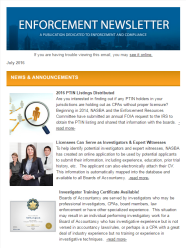Enforcement NewsletterJuly 2016In each previous issue of the Enforcement Newsletter, we have focused on a separate Component of Enforcement. The previous issue looked at Component 9: Monitoring Provisions & Sanctions.
Discussions during the 2016 Legal Counsel Conference reinforced our earlier observations that probation monitoring is handled very differently among the Boards. In order to assist Boards in creating a more uniform and formalized approach to probation monitoring, the Enforcement Resources Committee already included several probation tools within the Enforcement Resource Guide. The Guide includes two sections of attachments which provide a great resource for Boards to reference when searching for new procedures or forms for the complaint and disciplinary process. The "Guiding Documents" section includes policies, procedures, guidelines, and manuals shared by nine Boards of accountancy to aid other Boards in their enforcement process. The "Sample Forms & Reports" section includes three specific documents under Component 9: Monitoring Provisions & Sanctions. One document is a procedural flowchart that can assist Board staff and licensees in understanding the proper flow for monitoring an Order that provides either probation, limited scope, or compliance only (requiring some remedial action to be taken). Another sample document is a Probation Monitoring List, which is a spreadsheet format for monitoring each file placed into probation status, the requirements of each order, date of completion of each required action, current status, and closure of the file. The third sample document is a Probation Report. The Report would be utilized to provide a written summary of the complaint, discipline, and status of probation to the Board or complaint review committee. If your Board utilizes probation as a disciplinary status, then please check out the available probation tools in the Enforcement Resources Guide located on the Enforcement Tools web page of NASBA.org. The Guide is password protected and is available to all Executive Directors and Board staff as requested by the Executive Directors. This password protected status allows us to encourage Boards to share helpful documents through the Guide, such as the guides, manuals, and sample forms discussed above. |
Full Newsletter |


